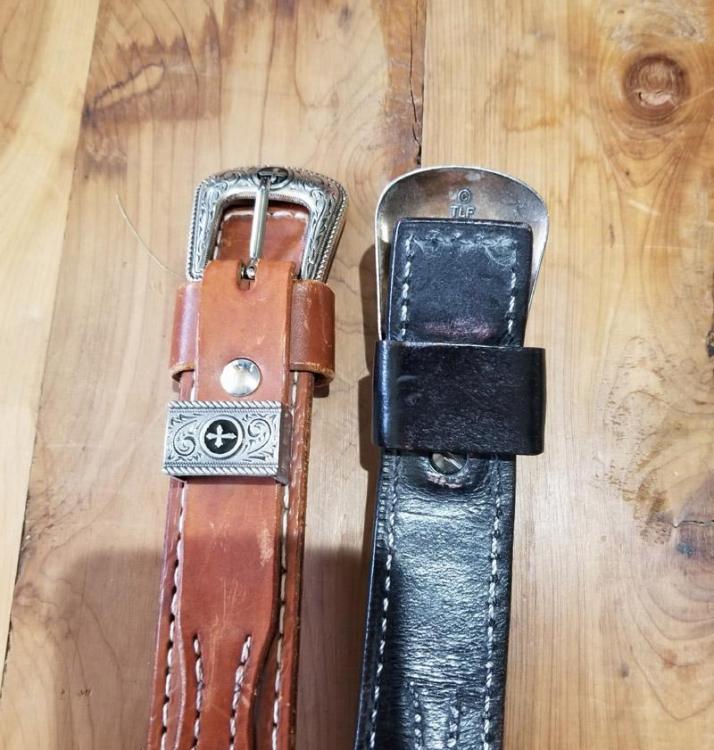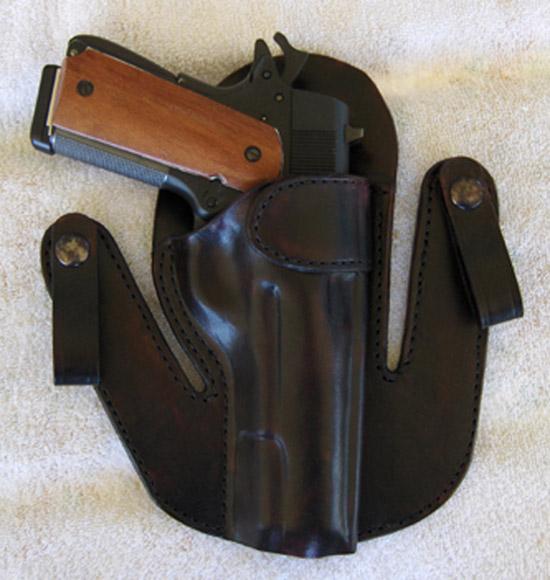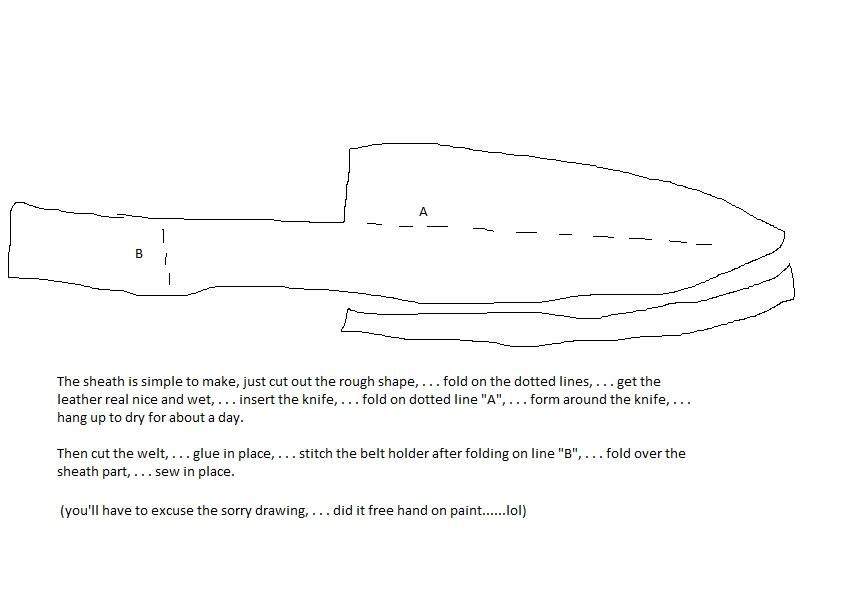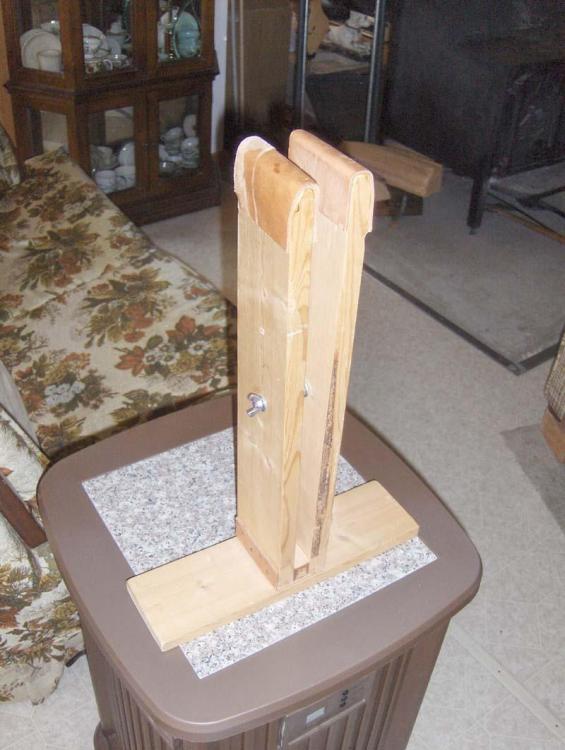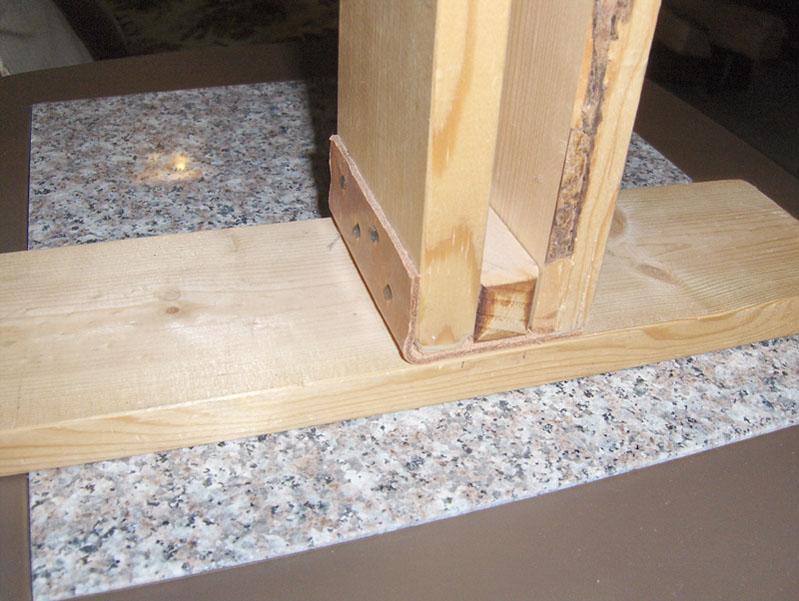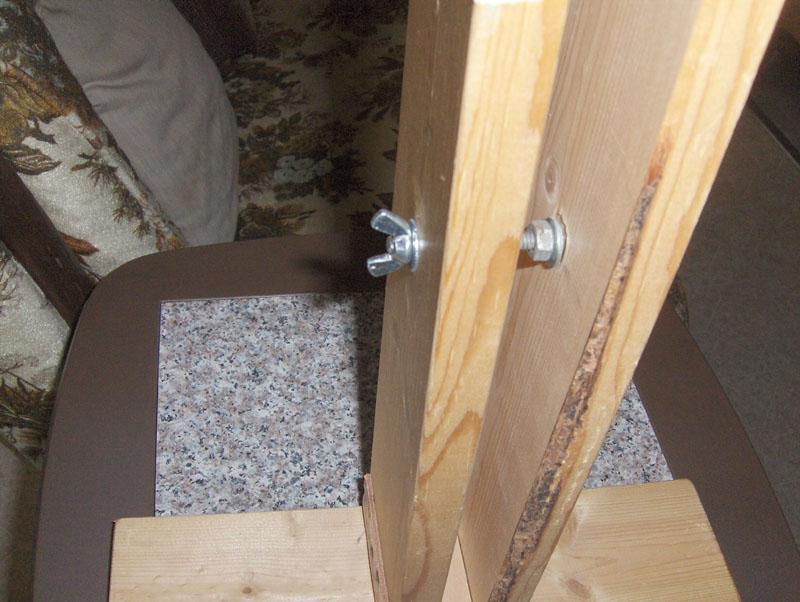-
Posts
5,229 -
Joined
-
Last visited
Content Type
Profiles
Forums
Events
Blogs
Gallery
Everything posted by Dwight
-
Here is my brown one and my black one. The pictures probably tell you ore about it than I could write in a week. May God bless, Dwight
-
I'm with Frodo, . . . two layers of 7/8 oz, . . . sometimes I'll shave one down so that the overall thickness is .200 or so. As far as the overlap, . . . you want the piece in your right hand to go under the part in your left hand, . . . and slip into a loop on the back of the belt, . . . so it stays even when you cinch it up. Cheap skates making Ranger belts leave the loop off of the back thinking they are saving something, . . . and it ruins the whole look of the belt if the wearer has it in the first or second hole. Looks like a leather tow rope holding his gut in. May God bless, Dwight
-
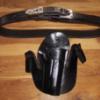
Why the Rabbit Ears
Dwight replied to LiftPig's topic in Gun Holsters, Rifle Slings and Knife Sheathes
Actually the loops and the belt are a very small part of the picture. They are much more for allowing the holster to be hidden by tucking in the shirt around the holster. May God bless, Dwight -
I kept trying to figure out why my sound wasn't working. One way or another, . . . I kinda shut it down in the late evening when the Mrs is in bed, . . . thought I'd really done it this time, . . . Finally figured there must not be a sound track. Anyway, . . . I figured it out without the play by play. Thanks, may God bless, Dwight
-
Ummm, . . . no sound . . . May God bless, Dwight
-
John Bianchi, . . . professional holster maker of some 60 years or so, . . . often used a bath of neatsfoot oil to finish his holsters, . . . and nothing else. He did a set of VHS videos featuring a western rig and it was done that way, . . . I like it myself sometimes. Otherwise, . . . Resolene is my finish of choice. May God bless, Dwight
-
Tandy sells acrylics that have always done good for the few projects I've painted. Just remember, . . . nothing painted will always stay pristine, . . . I always go over my paint work with Resolene, . . . and I go over the painted part a couple extra times to protect the art work. Sadly, . . . using the leather object will eventually wear the finish, . . . and can wear it off the inside. In the case of a clutch purse, . . . holster, . . . or other such piece, . . . it can get wet from the inside, . . . but unless it gets fully soaked, you will usually be alright, . . . the finish itself tending to try to retain the shape. Personally, . . . I always seal the whole project, . . . inside and out, . . . and Resolene is my product of choice. EDIT: The one exception to sealing the inside is if I use a soft liner such as suede or pigskin. May God bless, Dwight
-
If we lived close enough we could make a good living together, . . . I'd sew, . . . you'ld tool, . . . and we'd share the profits. Seriously, . . . really good looking work, . . . far, far beyond my present or anticipated skill level. Making holsters, . . . CCW belts, . . . that's my game. May God bless, Dwight
-
I use a 1 inch wide Harbor Freight bristle brush, . . . they're about 50 cents each there. Never had a problem in over 15 years. May God bless, Dwight
-
Mark, . . . do yourself a favor and when you remake this, . . . undercut the back side below the mag ejector button, . . . other paddle holsters as well as yours, . . . are only a nudge away from a lost mag, . . . tuning your fine firearm into a single shot. Mine did that to me one time when a coon was robbing my hen house. I learned a valuable lesson about holsters that day. May God bless, Dwight
-
Not sure what you are attempting here, . . . Resolene is a FINAL, . . . LAST THING product. It is the cherry you put on top of a hot fudge sundae. There is no way it can take dye off a product that has been properly dyed and finished. May God bless, Dwight
-
The same black grease I use on my tractor, mower, chain saw, etc. works fine on my Boss, . . . has for almost 15 years. When I don't have black, . . . the brown stuff fills the bill. May God bless, Dwight
-

Getting started with leatherwork suggestions?
Dwight replied to ElectricZombie's topic in How Do I Do That?
The first thing you need to decide, . . . what do you want to do with leather. The people making high end leather vests would not know most of the time where to start with a saddle. Many holster and belt makers would have a tough time doing a really nice ladies' purse. Determine what product you want to produce, . . . go to a local Tandy store, . . . tell them, . . . let them give you some good advice. May God bless, Dwight -

Advice needed for sheath
Dwight replied to DaveP's topic in Gun Holsters, Rifle Slings and Knife Sheathes
I like wrapped sheaths, . . . with a welt to protect the stitches, . . . looks like it would work for all three of em. Nice part about wrapped sheaths, . . . you can do it in two pieces, . . . the sheath and the welt, . . . May God bless, Dwight -
A friend had a pair of suspenders with these to protect the leather seats in his Mustang, . . . the others scratched the seats badly. He loves em, . . . so I made a pair, . . . mine are 1 inch wide, . . . no elastic, . . . and I have no problem at all with them. They are really comfortable, . . . but if I decide to re do them some day, I'll make them 1 1/2 inches wide, . . . as I have others that are just a tad more comfortable with the wider width. Mine were made with embossed veggie tan that looks like gator leather. May God bless, Dwight
-
Look up on the top of the screen to the right, . . . little envelope, . . . you have a PM there. May God bless, Dwight
-
I feel for you my friend, . . . as I often have the same problem with work gloves. And, no to akguy59, . . . larger gloves become more of a liability because your hand slides around in them. I mostly just soaked the gloves in warm, . . . almost hot, . . . water, . . . then wore them until they dried out. That usually cured the problem. But if you are sure you want to do this, . . . cut the seam going down the pinky finger, . . . then turn most of the glove inside out, . . . that should give you a flat surface so that you can put the patch over there where you want it. Make sure you glue it down with contact cement first. May God bless, Dwight
-
As above, . . . thank you for your efforts and information. May God bless, Dwight
-
If you have never done a belt before, . . . you need to carefully measure the length you need, . . . by taking a belt worn by the customer, . . . measuring from the front edge of the buckle, . . . back to the most used hole. That is your belt length. I punch 7 holes in the belts I make, . . . so when I get to this point, . . . I will later mark that as the middle hole length. Then you work the end for the buckle, . . . do you have a pattern or template for that?? Do you also have a pattern or template for the tongue end?? When I cut the belt blanks, . . . I actually "need" right at 9 inches beyond the measurement for the belt length. I will cut 10 or 12 inches over, . . . just in case there is a flaw or something I need to work around. I make the outside piece, . . . and do whatever decorations are necessary, . . . I then lay the liner down on the belt with the buckle end folded over like it would be to put the buckle on, . . . measure and cut the liner. I use Weldwood contact cement to put the two pieces together, . . . Once they are together, . . . I even up the edges all around with a belt sander. Stitch the two pieces together, . . . bevel and burnish the edges, . . . punch the 7 holes at the tongue end, . . . dye, . . . finish May God bless, Dwight
-

Dual SA Cowboy Rig
Dwight replied to MLGilbert's topic in Gun Holsters, Rifle Slings and Knife Sheathes
Yep . . . good lookin rig, . . . Go in hock, . . . get that other pistola, . . . it's worth it, . . . May God bless, Dwight -
I make and sell my CCW belts by cutting two consecutive strips 1 1/2 inches wide from 7/8 oz veg tan leather, . . . glue em together, . . . sand the sides smooth, . . . stitch the edges, . . . punch the holes, . . . dye and finish, . . . put on a buckle, . . . send it to my customer. That's the way I do it. May God bless, Dwight
-
I guess I'll play odd man out, . . . I have a leather western style hat, . . . a grey Kepi, . . . and a military style ball cap, . . . none are lined and have all served me well for decades. Ummm, . . . why a lining? Sounds like a lot of work for something totally un-necessary. But if you got to have it, . . . Joann Fabric is the place to go for material, . . . go see the folks there, . . . they'll help you. May God bless, Dwight
-
Yes, . . . the brace would be about 2/3 the thickness of the pliers. And yes, . . . the basic terminology is a welt. I always put a welt up the outside seam of my cowboy holsters, . . . knife sheaths, . . . and tool holders like this. 1) it makes the molding easier and 2) it gives the finished product more of a professional look I think and 3) the tool holder will eventually become looser, . . . allowing the tool to bottom out, . . . and the tip of the pliers hitting a welt will not hurt the holder, . . . but if it gets to the stitches, . . . trouble lays ahead. I would suggest a couple things, . . . google "drill sander" and take a look at some of the ideas there. Any kind of a powered sander will give you a quicker and more professional looking edge. Plus, . . . stitching pony's are a piece of cake to make, . . . see below. You are doing good, . . . keep up the good work. May God bless, Dwight
-
For something like this, . . . I would first cut a rough shape of the front, . . . and I would not have cut the top edge straight off, . . . a slightly rounded up look. Bevel and burnish that top edge. I would then make something or find something that is about 2/3 the thickness of the pliers, . . . wood, plastic, other leather, etc, . . . but which outlines the pliers fairly close. Lay that all around the pliers. Next, . . . wet mold the front piece, . . . hang it up to dry for 24 or so hours. When dry, . . . lay the front face down on a terry towel, . . . put braces under the edges, . . . lay the pliers in that front "shell". For these types of "holsters" I also will put in another piece of leather between the front and back, . . . it is the basic outline of the tool itself, . . . will be about 3/8 of an inch wide, . . . and will follow the coutour of the edge of the holster, . . . all the way around. I usually get it by first making the front piece, . . . laying it down on another piece of leather pretty much the same size, . . . outline it, . . . cut it out, . . . then lay the tool on that piece, . . . outline the tool, . . . cut out the outline, . . . discard that piece from the middle. Glue it to the front piece, . . . making sure the tool will slide in and out easily. Cut out the back piece, . . . cut, bevel, and burnish the belt loop piece, . . . put my makers stamp on the back of the belt loop then wet it and fold it over, . . . sew in place. Wet mold the back piece, . . . shaping it over the tool laying in the front piece with the spacer glued in place. Allow back to dry for 24 hours or so, . . . glue the back to the other two pieces. Note: always cut front and back and spacer piece bigger than the final product will be, . . . by a good half inch. In that half inch you will have wiggle room for gluing and shaping your final product. Also that will aid when they are glued together you do not have to fuss and sweat getting it lined up perfectly. After all is glued (I only use Weldwood contact cement for my gluing) I use a roller, . . . pincher, . . . something to seriously squeeze the edges together. Go to the belt sander, . . . sand those edges flat and even all the way around. I also would sand away that little peak you had sticking out on both sides about half way down. In about a month of good use, . . . that tip point will get frayed and funky looking, . . . will ruin the looks of an otherwise good looking holster. Prick . . . punch, . . . and stirch the edges (or in my case, . . . hit the sewing machine). Bevel and burnish the edges, . . . dip dye, . . . finish, . . . and congratulate myself on a good job. Anyway, . . . that would be my process. May God bless, Dwight



